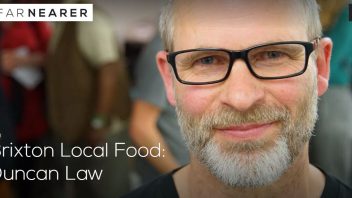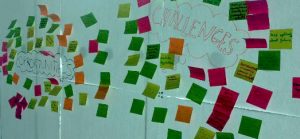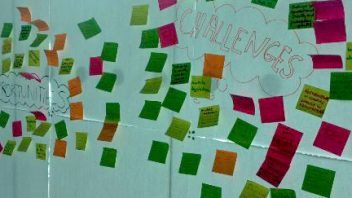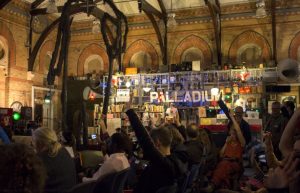Create a shared vision and strategy

Are you all heading in the same direction?
Vision & purpose
One of the most powerful things we can do to change our society is to change the stories we tell ourselves and each other. Creating new visions of the future is one of the things that distinguishes the Transition approach from most other sustainability/environmental approaches – rather than campaigning against a grim and disastrous portrayal of the future, Transition starts with creating a positive vision of a future we want.
Here we suggest it’s important to work with your partnership group to define a shared vision for your new local economy. This might include a headline ‘purpose’, desired characteristics and enablers or other things that need to be in place to underpin this new economy. For example, Totnes’s partnership group have defined the following:
We suggest that you run a workshop with your partnership group to come up with something appropriate for your own community. This approach can help:
- Provide opportunities for people to develop their own ideas/visions about what their local economy would be like, if it were more resilient and sustainable, and the pathways to get there.
- Identify which of these ideas are shared in the group and which are not, and to explore what this means.
- Weave together the agreed ideas into a shared vision that can be written up as your own ‘vision for our local economy’.
- Agree ways of taking it forward together, e.g. with developing an action plan and other enabling projects.
There are different ways of doing visioning work, and it’s important to pick one that will work for your audience. For example, at the Totnes partnership group workshop, there were general and small group discussions about desired economic purpose, kinds of growth, how the needs of the community get met today by businesses and other organisations and how they could be, and what’s in the power of this group to influence. Though this wasn’t ‘classic’ visioning as outlined below, from this more informal approach emerged their new purpose and agreement of what they wanted to see.
More ‘classic’ visioning usually invites attendees to relax, close their eyes and use their imagination, based on a scripted visioning exercise. Here we don’t try to predict the future, instead we imagine what we would like it to be. This uses different parts of our brain and calls forth different parts of ourselves. This method does not work for everyone and may not work for you or your audience – but many people have got a lot from doing this kind of approach.
Who should be involved?
In Totnes they chose to just do the vision/purpose workshop with the partnership group, as there had already been a number of other visioning workshops held with the wider community over the previous few years.
Of course you can do this vision/purpose workshop with a wider group – others in your Transition group, the community, local businesses and so on – and you may well choose that approach, like TT-Brixton did. But there is something very useful and bonding about doing this work just with your partnership group, it helps unite the group and put it on a firmer footing.
So we suggest this group is higher priority, and then if you have capacity you can consider also doing a wider one. As always, it’s good to be clear about the purpose of the workshops, and how the outputs will be used. Ask why are you involving a wider group at this stage? Is it the right time?
Create a collective strategy or plan
Your strategy or plan is a means to bring your vision/purpose into being, ideally informed by your local case for change, and begins to carry out your economic transformation.
At a high level, a strategy lays out your objectives and approach, defines what activities and projects will be done and considers the resources available. Usually a strategic time frame is 3-5 years, and we suggest 3 years is probably far enough in the future given the uncertainty of current times. It might include references to other related work, local or otherwise, and also consider how progress would be measured. It’s important this acknowledges work already underway.
This strategy might be represented as a simple 3 year plan that emerges from your more detailed case for change work or similar activity. It’s important that your strategy or plan is developed together with your partnership group to ensure shared ownership and commitment, where you jointly agree priorities, responsibilities and source resources.
Things to get you started
- Workshop approach without visioning as used by Totnes group to produce this, and here’s an approach with visioning.
- Totnes’ 3 year REconomy plan from the Economic Evaluation work, jointly produced by the partnership group.
- See the sector-based visions and action plans in Sustaining Dunbar’s Local Action Plan.
Strengthening
- Transition Colorado strategic plan that emerged from Food Shift work & JPNet’s strategy [coming].
- A general vision from the new economics foundation (see p9) is contained in their Great Transition publication.
- A (slightly deluded?!) vision from Business in the Community that might help stimulate discussion with your business leaders.
- More help and examples of visions over on the TN website.







Connect